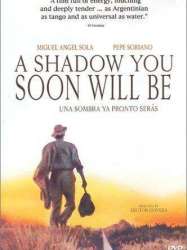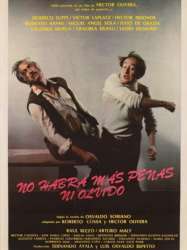Osvaldo Soriano is a Novel Argentin born on 6 january 1943 at Mar del Plata (Argentine)

Osvaldo Soriano (January 6, 1943 – January 29, 1997) was an Argentine journalist and writer.
The work became his first novel, Triste, solitario y final (English: Sad, lonely and final), a melancholic parody set in Los Angeles with the famed fictional Philip Marlowe detective as his joint investigator. It was some months after the publication of his novel that he visited the American city, and actually stood by the grave of Stan Laurel, leaving there a copy of his book.
Shortly after the Proceso de Reorganización Nacional coup d'etat in Argentina in 1976, he moved to Brussels first (where he met his wife Catherine), and then to Paris, where he lived in exile until 1984. While in France he befriended Julio Cortázar, with whom he founded the short-lived experience of the monthly magazine Sin censura. After the fall of the military junta, he returned to Buenos Aires, and the publication of his books were met with large success, not only in South America but also in Italy and several other countries where his works begun to be translated and published.
In his books, Soriano succeeded in mixing his experiences as a democratic activist and as a strong critic of the violence wielded by reactionary governments with extraordinary humour. A lover of both football/soccer and cinematography, he often honored both in his work. Soriano was a known San Lorenzo fan.
After his death in Buenos Aires in 1997, he was buried in the La Chacarita Cemetery in Buenos Aires. His work has since been translated into at least fifteen different languages, and has inspired film directors and producers on fiction and documentary works based on his novels and life experience.
Source : Wikidata
Osvaldo Soriano

- Infos
- Photos
- Best films
- Family
- Characters
- Awards
Nationality Argentine
Birth 6 january 1943 at Mar del Plata (Argentine)
Death 29 january 1997 (at 54 years) at Buenos Aires (Argentine)
Birth 6 january 1943 at Mar del Plata (Argentine)
Death 29 january 1997 (at 54 years) at Buenos Aires (Argentine)
Biography
Soriano was born in Mar del Plata, Argentina. He became a staff writer at La Opinión right from the start in 1971 when editor Jacobo Timerman founded the newspaper. La Opinión was permeated with progressive politics, and soon there was an attempt to squash the left-wing influence within the paper. After six months of not having any of his articles published, Soriano began writing a story in which a character named Osvaldo Soriano reconstructs the life of English actor Stan Laurel.The work became his first novel, Triste, solitario y final (English: Sad, lonely and final), a melancholic parody set in Los Angeles with the famed fictional Philip Marlowe detective as his joint investigator. It was some months after the publication of his novel that he visited the American city, and actually stood by the grave of Stan Laurel, leaving there a copy of his book.
Shortly after the Proceso de Reorganización Nacional coup d'etat in Argentina in 1976, he moved to Brussels first (where he met his wife Catherine), and then to Paris, where he lived in exile until 1984. While in France he befriended Julio Cortázar, with whom he founded the short-lived experience of the monthly magazine Sin censura. After the fall of the military junta, he returned to Buenos Aires, and the publication of his books were met with large success, not only in South America but also in Italy and several other countries where his works begun to be translated and published.
In his books, Soriano succeeded in mixing his experiences as a democratic activist and as a strong critic of the violence wielded by reactionary governments with extraordinary humour. A lover of both football/soccer and cinematography, he often honored both in his work. Soriano was a known San Lorenzo fan.
After his death in Buenos Aires in 1997, he was buried in the La Chacarita Cemetery in Buenos Aires. His work has since been translated into at least fifteen different languages, and has inspired film directors and producers on fiction and documentary works based on his novels and life experience.
Usually with
Filmography of Osvaldo Soriano (3 films)
Scriptwriter

A Shadow You Soon Will Be (1994)
, 1h45Directed by Héctor Olivera
Genres Drama, Comedy
Actors Miguel Ángel Solá, Roberto Carnaghi
Roles Novel
Rating59%






The Autograph (1984)
, 1h32Directed by Peter Lilienthal
Genres Drama
Themes Seafaring films, Transport films, Political films, Films about Latin American military dictatorships
Actors Hanns Zischler, Georges Géret
Roles Novel
Rating65%






Funny Dirty Little War (1983)
, 1h20Directed by Héctor Olivera
Origin Argentine
Genres Comedy, Comedy-drama
Themes Politique, Political films, Films about Latin American military dictatorships
Actors Federico Luppi, Miguel Ángel Solá, Ulises Dumont, Víctor Laplace, Lautaro Murúa, Rodolfo Ranni
Roles Novel
Rating69%





Ricardo Guglielmini is the mayor of Colonia Vela, a small countryside village in an undisclosed province of central Argentina. He plots with the local Peronist political boss, Héctor Suprino, and union leader Reinaldo to get the deputy mayor Ignacio Fuentes out of power due to his increasing popularity (which threatens Guglilemini's decade-long hold on the mayor's office), despite Fuentes being an avid peronist and having once worked under Juan Domingo Perón himself.
 Connection
Connection




